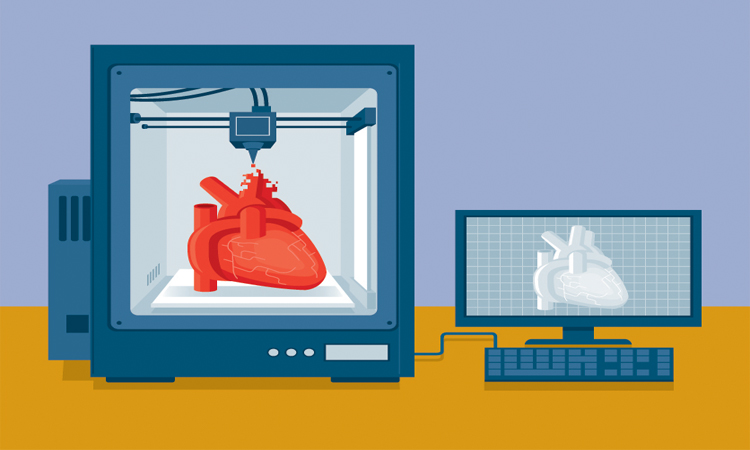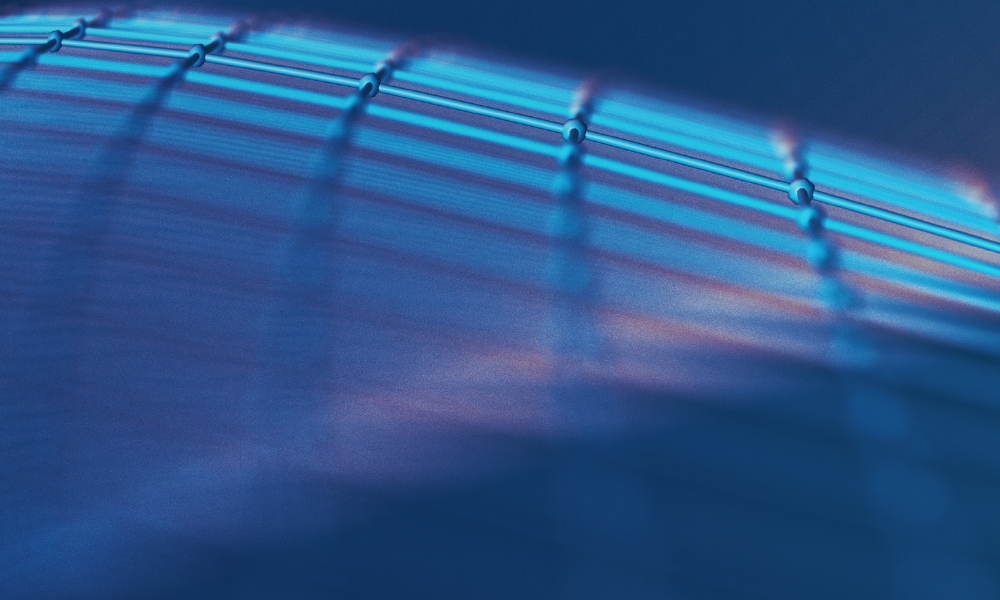3D Printing & Bioprinting in Pharmaceutical Manufacturing

When Aprecia Pharmaceuticals’ anti-seizure medication Spritam (levetiracetam) became the first 3D-printed* drug product to be approved by the US Food and Drug Administration (FDA) in 2016, it also became the first confirmed drug supported by a new team at the agency that encourages industry uptake of emerging pharmaceutical manufacturing technology.
* 3D printing, also known as additive manufacturing, refers to a group of processes and materials that can produce a three-dimensional solid object from a digital file by applying successive layers of material.
“Industry is supportive of innovative technology because it can make manufacturing more efficient, yet they may be hesitant to implement it due to perceived regulatory uncertainty,” said Sau (Larry) Lee, PhD and chair of the Emerging Technology Team (ETT) in the Office of Pharmaceutical Quality (OPQ) of the Center for Drug Evaluation and Research (CDER) at the FDA.
“While the regulatory process remains the same, what has changed is the industry’s recognition of the FDA’s willingness to accept the adoption of innovative technology. ETT provides a forum for industry to engage the agency, discuss their technology, and help reduce uncertainty. “The challenge on the industry side is to determine which type of products will use these technologies,” Lee continued. “Because the technology is new, industry sometimes needs additional clarity regarding the regulatory expectations. FDA can help them apply these technologies to pharmaceutical applications. We tell them what types of data we want to see and then it’s up to the company to generate the appropriate dataand to have an early engagement with regulators.”
Staffed by representatives from all relevant CDER review and inspection programs, the ETT is meant to encourage and support the adoption of innovative technology to modernize pharmaceutical development and manufacturing where the FDA has limited review or inspection experience. Among the emerging technologies the team has addressed to date are continuous manufacturing, advanced analytics, aseptic filling closed systems, and 3D printed tablets like Spritam.
Beyond Manufacturing Tablets
3D printing and bioprinting have the potential to transform drug making beyond manufacturing tablets. The technology is also being used to create tissue and miniature cellular models, some of which can even mimic the biology of human organs.
“We will soon see the printing of cell-based diagnostics for the rapid screening of drug candidates and chemotherapeutic agents,” said John Fisher, chair of the Fischell Department of Bioengineering at the University of Maryland and an expert in bioprinting. “This should reduce the need for animal studies or narrow down candidates to be tested in conventional ways, thus reducing costs.”
Bioprinting is the process of creating cell patterns using 3D printing technologies to produce complex live tissues. While the technical challenges related to living cells and tissue construction make bioprinting more complex than non-biological 3D printing, together they can be used to create surgical models, molds for titanium implants, prosthetics for amputees, dental crowns and bridges, cranial implants, and, hopefully one day, bone, heart valves, and even a functional heart. Bioprinting is faster and cheaper than previous technologies, with a prosthetic hand costing as little as $150.1 The Ottawa Hospital, in partnership with the University of Ottawa, has opened a new medical 3D printing program the first based in a Canadian hospital—that recently created 3D-printed prosthetic hands for two patients.
In addition to prosthetics and cellular networks, 3D printing and bioprinting will change how drug candidates are tested, how drugs are manufactured, the supply chain, and industry dependence on animal testing.
3D Manufacturing
Spritam is a good example of how 3D manufacturing has evolved and how it can enhance product characteristics. The drug is made by printing medication and binders layer by layer, without compression, punches, or dies.3 This produces higher drug loading—up to 1,000 mg—than can be obtained by conventional manufacturing. The tablets also dissolve more quickly in the mouth, making it a boon for patients with dysphagia. But there’s still another benefit:
“The tool-less making of tablets permits novel pill shapes, which can affect the absorption rate,” said Peter Denmark, North American sales manager for EnvisionTEC, a manufacturer of 3D printers and materials. “It allows for patient-specific drugs for which the dosage can be calculated per patient per disease due to additive manufacturing.”
Using conventional manufacturing, drug makers can produce up to 1.6 million tablets per hour, a number that far exceeds what a 3D printer can currently produce.4 Thomas West, project director and manager of intellectual property at Aprecia Pharmaceuticals, doesn’t see this as a limitation, however.
“The real purpose of 3D printing is to create products with unique functionality that cannot be achieved by high-speed compression tableting or other traditional manufacturing technologies,” he said. “Over time, we expect 3D printing technology to evolve and gain efficiencies, but the focus will be on the unique functionality of the end product rather than a way to replace traditional manufacturing of standard tablets.”
As an example, West points out that 3D printing technology can be used in a centralized manufacturing setup to make differentiated products, because those don’t compete with traditional tablets.
Bioprinting Equipment
The simplest bioprinted tissue is a single layer, like skin. Organovo and Invetech partnered to develop the first 3D human tissue bioprinter in 2009. The sector has expanded greatly since then. One company embracing the technology is L’Oreal, which is working with Organovo to bioprint human skin to test cosmetics.8
“All of our customers are patterning cells and biomaterials to do new science or build useful products,” said Danny Cabrera, CEO of BioBots, a biotechnology firm in Philadelphia, Pennsylvania, US. The company makes 3D bioprinters that can use ink containing human cells. “Some of our customers are building living tissues out of a patient’s own cells, then using those tissues to test therapies and determine the best treatment for an individual. BioBots can build personalized living things out of cells and biomaterials.”
A typical bioprinting system includes hardware, design software, and inks. The software translates files from 3D computer-aided engineering and design tools such as SketchUp, AutoDesk, or SolidWorks into printer instructions. The inks can be cell lines or chemical material such as collagen, gelatin, polyethylene glycol, or alginate—anything that can be extruded from asyringe.
Like EnvisionTEC, BioBots also works with pharmaceutical customers who use 3D bioprinters to make pills. “They’re exploring how different solutions dissolve at different rates and how geometry controls dosing, down to the minute,” said Cabrera. “Their goal is to personalize dosages and diffusion profiles for individual patients.”
3D printing and bioprinting have the potential to transform drug making
Drug Shortages And Recalls
The ETT sees a gap between the basic research and technology development conducted by universities and government agencies and its adoption by the private sector,7 and uses a collaborative approach to bring the groups together.
“The ETT plays a leadership role in the OPQ quality assessment team for applications containing an emerging technology,” said Lee. Team members evaluate ways that existing FDA guidance and policy may impact uptake of innovative technology. The ETT’s long-term goals include modernizing pharmaceutical development and manufacturing, in large part to address the problem of product recalls and drug shortages.
“A lot of shortages and recalls are related to quality issues, either due to manufacturing processes or aging facilities,” he explained. “The pharmaceutical industry tends to invest more in drug discovery than manufacturing. This means that manufacturing technology has not progressed as significantly. The FDA hopes to address this by promoting technology improvements that provide flexibility, robustness, and agility of pharmaceutical manufacturing. The goal is more reliable technology that reduces the likelihood of defects and errors.”
Traditionally, the FDA only talks to a company once it has a drug candidate, but conversation with the ETT can start earlier because it focuses on technology. “The more they tell us about the drug product or substance the better,” said Lee. “The level of detail we can provide in our comments will vary depending on the level of detail they provide.”
The ETT approved Spritam, and was also instrumental in supporting approval for a switch from batch to continuous manufacturing for Janssen’s HIV medication Prezista (darunavir). “FDA successfully worked to provide regulatory clarity to the applicants and reviewed their submissions in a timely manner,” Lee said. “The ETT was only established two years ago, yet we get lots of requests, and have had a good response from industry.”
In addition to conducting its own research, the FDA works with academia and industry to assess the use of these technologies to support product applications.5 Last year the agency issued a draft guidance covering 3D printing protocols and devices.6
Supply Chain
3D printing’s effect on the supply chain will result in on-demand production, local manufacturing, and the creation of unique, individualized products. Dentists, for example, are already printing 3D crowns and bridges. In drug making, 3D printing will enable low-volume production and increased speed to market.
“The supply chain will be shortened and become hyper local,” EnvisionTEC’s Denmark said. “Think of the compounding pharmacies having an additive machine in house to produce patient-specific pills. And for drug testing of new candidates, dosage can be changed on the fly, with less expense, locally.”
The potential for localized and centralized manufacturing might, as many in the biotechnology sector advocate, keep aspects of drug manufacturing in the United States. “The overall value proposition for the differentiated dosage forms that 3D printing allows can support manufacturing in places like the US, as Aprecia does,” said West. “This is instead of relying on asymmetry in labor costs from abroad.”
Since 3D printing is in its infancy in the pharmaceutical industry, its unique value creation is not yet through cost reductions, but “through proprietary innovations in technology, which for us are US-based,” said West. “The technology will improve in the commercial context as innovation continues.” At the same time, other parts of the supply chain, such as the sourcing of raw materials and the manufacture of active pharmaceutical ingredients (APIs), are not affected by 3D printing technology. One challenge for the industry is transforming APIs into materials that can be 3D printed.
One of the most exciting technology developments is “Organs-on-Chips"
Bioprinted Tissue And Model Organs
Bioprinting tissue uses “inks” that include cellular matrix and support materials, as well as sacrificial material that is washed away after printing.8 Fisher’s lab at the University of Maryland collaborates with KeraNetics, a North Carolina–based biomaterials company, to bioprint purified keratin proteins that the company uses in its wound healing and tissue regeneration products.
Fisher’s lab has also bioprinted placenta and other tissue models to study preeclampsia and the transport of pharmaceuticals from mothers to fetuses in utero. Other long-term potential uses include making miniature organs for drug testing. While experimental bioprinted heart valves have been produced13 and the FDA recently approved cell-based cartilage regeneration, whole organ constructs of heart, liver, or other organs are still a distant goal.9
“These are interim steps in a long process,” said Fisher. “You have to keep the market in mind. The mechanical heart valves and bovine heart valves work well. A tooth could be engineered, but will it be cheaper? What dentists are constructing now is viable and works.”
He would like to see more collaboration with the pharmaceutical industry in the development of printable materials. “There is a need to develop more materials and more material systems,” he said. “The pharmaceutical industry, with its ability to screen and develop molecules, could offer a wonderful synergy.”
- 1CBC News. “Ottawa Hospital Opens 1st Medical 3D Printing Program of its Kind in Canada.” 4 February 2017. http://www.cbc.ca/news/canada/ottawa/ottawa-hospital-medical-3dprinting-1.3967350
- 3S. Reardon, S. “’Organs-on-Chips’ Go Mainstream.” Nature, 15 July 2015. http://www.nature. com/news/organs-on-chips-go-mainstream-1.17977
- 4Aprecia Pharmaceutical. “3D Printing.” https://www.aprecia.com/zipdose-platform/3dprinting.php
- 8 a b Lee, S. “CDER Emerging Technology Program and Quality Related Regulatory Science Activities.” GPhA CMC Workshop, North Bethesda, Maryland, 17–18 May 2016. http://www. gphaonline.org/media/wysiwyg/Meetings/CMC_2016/Sau_Lee.pdf
- 7———. Draft Guidance. “Technical Considerations for Additive Manufactured Devices.” 10 May 2016. https://www.fda.gov/downloads/MedicalDevices/DeviceRegulationandGuidance/ GuidanceDocuments/UCM499809.pdf
- 5Petch, M. “Just Say Whoa: GlaxoSmithKline and the Future of 3D-Printed Pharmaceuticals.” Autodesk Redshift. 13 September 2016. https://redshift.autodesk.com/3d-printedpharmaceuticals/
- 6US Food and Drug Administration. “The 3Rs of 3D Printing: FDA’s Role.” 21 December 2016. https://www.fda.gov/forconsumers/consumerupdates/ucm533992.htm
- 13Jana, Soumen, and Amir Lerman. “Bioprinting a Cardiac Valve.” Biotechnology Advances 33, no. 8 (August 2015). https://www.researchgate.net/publication/280866150_Bioprinting_a_ Cardiac_Valve
- 9Organovo Holdings. “L’Oreal USA Announces Research Partnership with Organovo to Develop 3-D Bioprinted Skin Tissue.” Press release. 5 May 2015. http://www.prnewswire. com/news-releases/loreal-usa-announces-research-partnership-with-organovo-to-develop3-d-bioprinted-skin-tissue-300077535.html

Organs On Chips
One of the most exciting technology developments is “organs-on-chips”: micro-engineered systems that mimic the functions of human biology. These living systems—about the size of a USB flash drive—are comprised of tiny channels lined with human cells to recreate the environment of an organ. One of the pioneers in commercializing organs-on-chips is Emulate Inc., a company developing examples for the lung, liver, intestine, kidney, and brain to be used in a lab-ready unit.
Emulate uses engineering principles to recreate the complex, dynamic cellular microenvironment in the living human body, including the flow of blood and air, as well as the mechanical forces that cause breathing and peristalsis. An example is Emulate’s lung-on-a-chip, which has at its center a porous membrane. On one side are airway cells from the air sac. On the other are capillary cells. Each layer of cells is in contact with a microfluidic channel.
Blood pumps through one channel in contact with the capillary cells; air passes through the other. Force on either side of the channel stretches and releases the cells to mimic the environment in the lung as we breathe.10 When these lung cells are challenged with medicines, chemicals, or toxins, their responses can be measured and observed, in part because of the transparency of the chips that allows the workings of the cells to be witnessed.
Organs-on-chips might reduce the need for animal testing,2 which, in addition to its ethical considerations, is expensive and doesn’t always predict human biology accurately. They may also reduce the time spent on drug testing, which currently can take years, costs hundreds of millions of dollars, and involves thousands of patients in clinical trials.
Based in Boston, Emulate is a private company that began as part of the Wyss Institute of Harvard University, where organs-on-chips were pioneered by Donald Ingber, PhD. The FDA and other government agencies provided grant support to Wyss, and Emulate is carrying on this partnership. 11 In April, the FDA’s Center for Food Safety and Applied Nutrition entered a collaborative agreement with Emulate to evaluate and qualify the company’s organs-on-chips technology as a model to study potentially harmful compounds in food, cosmetics, and dietary supplements.12 The FDA and Emulate will look first at the effects of these compounds on the liver, using Emulate’s liver chip.
“Emulate collaborates with many stakeholders involved throughout the drug development process, including regulatory agencies,” said Geraldine Hamilton, PhD, the company’s president and chief scientific officer. “Our aim is to evaluate our organs-on-chips technology so its functionality aligns with the requirements of regulatory research and filings with FDA and other agencies.
“Within the pharmaceutical industry, we’d like to see organs-on-chips used throughout the drug-development process, including the discovery of new drug targets, understanding disease mechanisms, and determining the efficacy and safety of new drugs,” added Hamilton. Emulate partners with companies including Merck, which uses its lung-on-a-chip to study asthma, and Johnson & Johnson, which uses its liver and thrombosis chips to study toxicity and side effects associated with new drug candidates.
Paul Vulto, cofounder of Mimetas, a Dutch company that also makes organs-on-chips, thinks the chips offer complex predictive models that are more accurate to the human condition than traditional cell culture or animal models.
“Organs-on-chips aren’t a monoculture,” he said. “They’re comprised of multiple layers of cells grown in 3D in a controlled co-culture, yet we can still handle them in large numbers and they’re robot compatible. We’re collaborating with the most innovative companies, but eventually the whole industry is going to do this because the old paradigm of simple 2D monocultures has proven to be not good enough.”
The Mimetas Organoplate is a 384-well plate whose bottom layer holds microfluidic channels that join four wells. Cells can be grown in a gel-collagen structure, while growth medium is perfused alongside. This form of bioprinting produces 3D cell culture of organ-like growth. For example, a neurovascular unit contains three layers of cells: neurons, astrocytes, and blood vessels. The tissue shows brain activity and can be challenged with test compounds.
“Toxicology models are currently primarily used by the pharmaceutical industry as internal decision-making tools,” Vulto said. “Once pharmaceutical companies have gathered sufficient evidence of the physiological relevance of these models, we can take this evidence to the FDA and the EMA. Regulatory agencies are important drivers of this technology in areas such as preclinical safety. It would be a great boost if some of these models get accepted.”
When it comes to biofabrication, we’re just getting started.
Personalized Medicine
Like other proponents, Hamilton and Vulto predict that organs-on-chips will not only transform drug development and testing, but will be used to develop personalized medicine, using a patient’s cells in the chip. An individualized organ-on-a-chip would then be used to find the best treatment option and avoid therapies that would be ineffective or cause harm.
“By combining organs-on-chips with an individual’s cells, this emerging approach offers new possibilities to understand our own health and the way in which medicine is practiced,” said Hamilton.
“Complex diseases, especially those that develop over a lifetime like cancer and Alzheimer’s, are multifactorial,” said Vulto. “These diseases are individual and are probably not going to be solved by a blockbuster drug that fits everyone. To find a good therapy you have to stratify patients and develop the right drugs for specific subtypes of the disease.
“We want to move into the clinic as a decision-making tool to select the right drug for each patient,” said Vulto. “Currently this uses molecular techniques like microarray or gene sequencing. There is an unmet need for phenotypic models that are more complex for diseases for which we don’t necessarily need to understand the mechanism. You can test if the tissue responds positively to the drug.”
“These first-generation organs-on-chips are better mimics of the human body than cells grown in a dish and, in some cases, animals,” said BioBots’s Cabrera. “Can they be better? Of course, but we’re nowhere near done. When it comes to biofabrication, we’re just getting started.”
- 10Cui, H. et al. “3D Bioprinting for Organ Regeneration.” Advanced Science News 6 (20 December 2016). http://www.prnewswire. com/news-releases/loreal-usa-announces-research-partnership-with-organovo-to-develop3-d-bioprinted-skin-tissue-300077535.html
- 2Burgess, M. “This ‘Heart on a Chip’ Could Finally Spell the End for Animal Testing.” Wired, 24 October 2016. http://www.wired.co.uk/article/heart-chip-harvard-sensors
- 11Wyss Institute. “Organs on Chips—Wyss Institute.” YouTube, 20 October 2011. https://www. youtube.com/watch?v=Mg2fJ0UBj_0
- 12Fitzpatrick, S. “‘Organs-on-Chips’ Technology: FDA Testing Groundbreaking Science.” FDA Voice, 11 April 2017. https://blogs.fda.gov/fdavoice/index.php/2017/04/organs-on-chipstechnology-fda-testing-groundbreaking-science/


